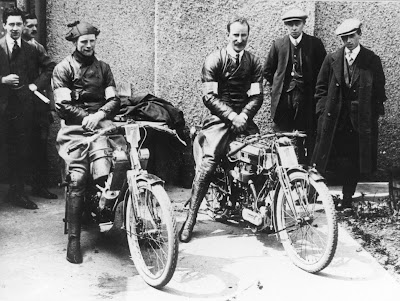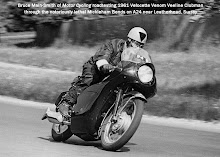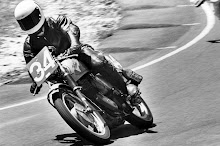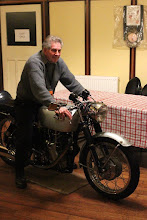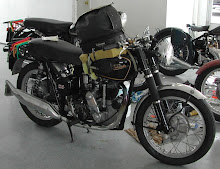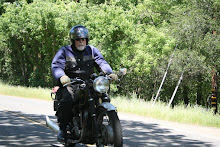In my last posting I mentioned my late Auntie Flo, was always on the lookout for little treasures to give my sister and I...
With my interest in motorcycling she often came across small photos in antique shops...
Real early stuff from the 1910 to 1920 period and all UK stuff....
They carry a sticker, "Demaus Transport Photographics, Stagbatch Farm, Monkland, Leominster, Herts, HR6 9DA"..
Either way I acknowledge their involvement, but for sure my Aunt never purchased from them directly.
I've also done several posts previously on Harry Beanham who, in his early motorcycling days in the 1920's toured northern Victoria and southern NSW, often on an ABC motorcycle or a Brough Superior, many times with friends.
Lets look at another small selection from the several photo albums of his I have acquired.
Harry first.....
Incidently if you've not viewed the early Harry Beanham stuff...type in his name in the search facility on the RHS of this blog.....
Left click on the images to enlarge them....
Following are the last of my Aunt's photos....
Ariel rider and others, circa1930 at Brecon...
Meet at the Swan's Nest Hotel, Stratford-on-Avon, circa 1912....
Copthorne hill climb, 1921....
Hipton hill climb Chatcombe Pitch near Cheltenham, circa 1921....
Madresfield speed trials, 1921...
New Imperial on Rosedale Abbey Bank...no date....
Redditch and District MCC rider on hill climb,likely Willersley, 1913...
Sgonina on a Sgonina special at Margam Park, 1922....
Sunday, November 27, 2011
Saturday, November 19, 2011
Early motorcycling photos...bought for me over the years by my late aunt Flo....
My late Auntie Flo, bless her heart, was always on the lookout for little treasures to give my sister and I...
With my interest in motorcycling she often came across small photos in antique shops...
Early motorcycling photos, which I really haven't scrutinised carefully, nor utilised until now.
Real early stuff from the 1910 to 1920 period and all UK stuff....
They carry a sticker, "Demaus Transport Photographics, Stagbatch Farm, Monkland, Leominster, Herts, HR6 9DA"..
I suspect they acquired them and popped them into the small envelopes with the label, although they may have the negatives.
Either way I acknowledge their involvement, but for sure my Aunt never purchased from them directly.
So lets view them together.....
Left click on the images to enlarge them, although Google has altered their blogger format such that the images when clicked on are no longer large, assuming you load large files as I do...can't fathom why....
F.A Applebee, winner of 1912 Senior IOM TT astride his 3.5hp Scott. On his right is J.R. Haswell, 3.5hp Triumph who finished 2nd and was the first private entry and the first single cylinder machine to finish.
Coalport speed hill climb,1911. A rider pushes off at the start.
North Middlesex MCC, Start of a road trial, circa 1913.
1919 Sunbeam outfit, Madresfield Speed Trials 1921.
Brooklands 500cc 1 hour race, 29th May 1920.
Triumph, circa 1914.
F.W.Giles, 3.5hp Triumph at Hopton Bank hill climb, circa 1913.
Jimmy Guthrie (AJS),left, winner Lwt TT, IOM, 1930.
The N.U.T. with which Eric ( who??? no surname given ) won the 1920 Sunbac Colmore Cup Trial.
Coalport Hill climb, circa 1911. Extreme left is A.J.Stevens of AJS in the same gear he wore for the 1911 IOM TT.
Redditch and DMCC road trial, circa 1913.
Another 1913 Senior contestant was H.Petty (Singer) seen here at Brooklands shortly prior to the IOM TT.
Indian riders for the 1913 Senior IOM TT event. The machines are wearing their practice numbers.
Water cooled Williamson flat twin in a trial, circa 1913.
With my interest in motorcycling she often came across small photos in antique shops...
Early motorcycling photos, which I really haven't scrutinised carefully, nor utilised until now.
Real early stuff from the 1910 to 1920 period and all UK stuff....
They carry a sticker, "Demaus Transport Photographics, Stagbatch Farm, Monkland, Leominster, Herts, HR6 9DA"..
I suspect they acquired them and popped them into the small envelopes with the label, although they may have the negatives.
Either way I acknowledge their involvement, but for sure my Aunt never purchased from them directly.
So lets view them together.....
Left click on the images to enlarge them, although Google has altered their blogger format such that the images when clicked on are no longer large, assuming you load large files as I do...can't fathom why....
F.A Applebee, winner of 1912 Senior IOM TT astride his 3.5hp Scott. On his right is J.R. Haswell, 3.5hp Triumph who finished 2nd and was the first private entry and the first single cylinder machine to finish.
Coalport speed hill climb,1911. A rider pushes off at the start.
North Middlesex MCC, Start of a road trial, circa 1913.
1919 Sunbeam outfit, Madresfield Speed Trials 1921.
Brooklands 500cc 1 hour race, 29th May 1920.
Triumph, circa 1914.
F.W.Giles, 3.5hp Triumph at Hopton Bank hill climb, circa 1913.
Jimmy Guthrie (AJS),left, winner Lwt TT, IOM, 1930.
The N.U.T. with which Eric ( who??? no surname given ) won the 1920 Sunbac Colmore Cup Trial.
Coalport Hill climb, circa 1911. Extreme left is A.J.Stevens of AJS in the same gear he wore for the 1911 IOM TT.
Redditch and DMCC road trial, circa 1913.
Another 1913 Senior contestant was H.Petty (Singer) seen here at Brooklands shortly prior to the IOM TT.
Indian riders for the 1913 Senior IOM TT event. The machines are wearing their practice numbers.
Water cooled Williamson flat twin in a trial, circa 1913.
Wednesday, November 9, 2011
A further full look at a scientific paper presented by B.Johnston the then technical manager of AMAL Ltd to an IMechE conference in the IOM 31st May- 3rdJune 1978
In Feb.2009 I introduced you in a book review to the bound IMechE conference papers presented at a 4 day conference in Douglas, IOM 31st May to 3rd June 1978...obviously just before TT time.
See my blog on this...
http://velobanjogent.blogspot.com/2009/02/design-and-development-of-small.html
I mentioned briefly two of the papers, one from an Amal Ltd representative, B.Johnston their technical manager at the time and the other by Jack Williams on the 7R AJS.
I treated both briefly.
This time I intend to concentrate on the Amal Ltd paper and present it in full, and I acknowledge copyright for the paper to B.Johnston, Amal Ltd, now obviously, because of the time frame, long gone and the Automobile Division and the Combustion Group of The Institute of Mechanical Engineers, London,UK.
Left click on the images to enlarge them and to read the text with the altered blog format by Google which appears to no longer allow you to enlarge an item. You may have to capture the image etc and print it out.
See my blog on this...
http://velobanjogent.blogspot.com/2009/02/design-and-development-of-small.html
I mentioned briefly two of the papers, one from an Amal Ltd representative, B.Johnston their technical manager at the time and the other by Jack Williams on the 7R AJS.
I treated both briefly.
This time I intend to concentrate on the Amal Ltd paper and present it in full, and I acknowledge copyright for the paper to B.Johnston, Amal Ltd, now obviously, because of the time frame, long gone and the Automobile Division and the Combustion Group of The Institute of Mechanical Engineers, London,UK.
Left click on the images to enlarge them and to read the text with the altered blog format by Google which appears to no longer allow you to enlarge an item. You may have to capture the image etc and print it out.
C123/78
SMALL ENGINE CARBURETTER DEVELOPMENT
B. JOHNSTON
Technical Manager, Amal Ltd
SYNOPSIS This paper deals with the development of carburetters during the last fifty years to the present day for what are conventionally termed 'small engines'. Covered are applications, both recreational and commercial, for a variety of uses; motor cycles, mopeds, scooters, marine engines (inboard and outboard), cultivators, generators, lawnmowers, pumps, chain saws, go-karts, snowmobiles etc. Starting in the late 1920's, by which time carburetter design had evolved into recognizable set categories, it follows the innumerable different inventions that had appeared during the formative years of internal combustion engine development and goes on to show the consolidation that took place until the early 1960's, the renaissance since then, the state of the art now, and anticipated future developments.
INTRODUCTION
1 For convenience this paper is divided into two parts. The first deals principally with carburetters for motor cycles, scooters, mopeds and derived power units used in snowmobiles, go-karts etc in short those with a high specific power output. The second covers the remainder; marine engines, lawnmowers, cultivators, pumps, chain saws and general purpose industrial applications usually, although not exclusively, with lower specific outputs. It is assumed that 'small engines' implies production units having individual cylinder capacities from about 50 up to the 500 and 600 cubic centimetre capacity region or multiples of such cylinders. The fact that the text draws heavily on the history of 'Amal Limited' since its formation in 1927 will be evident. This is inevitable and not simply a consequence of the author's long involvement with that company, but because Amal pioneered and dictated the worldwide fashion in small engine carburetters, particularly for motor cycles for the ensuing thirty years or so. That aside, the author has endeavoured to be impartial throughout and acknowledge other manufacturers' contributions wherever applicable. Besides those chosen for inclusion, there are no doubt many noteworthy omissions, but for the given subject and the period of time covered, the space available permits only a superficial resume'.
The motor cycle carburetter - 1930
2 In order to explain the trend in carburetter development, it helps to look back to the period covering the late 1920's and early 1930’s, when subtle but significant changes were taking place. It was a time of deep worldwide recession which caused the collapse and disappearance of many companies. It coincided with the end of the formative years of carburetter design and evolution. Until this period there existed innumerable manufacturers of carburetters of a variety of types, some good, others questionable, including many engine manufacturers making their own designs. Understandably, supply exceeded demand. The economic pressures helped to resolve the technical atmosphere; those companies with most commercial acumen and/or technical expertise asserted themselves. An example is the formation of Amalgamated Carburetters in 1927 (AMAL), by the merging of three prominent manufacturers. This process encouraged Amal to further design rationalization, resulting in adoption of the most technically satisfactory solutions and commercially viable products; a process that was inevitable but which, without a harsh commercial climate, would probably have been spread over many years. Co-incidentally the remaining manufacturers tended to specialize in particular sections of the market, ie automotive, motor cycles and other small engines.
3 The surviving designs fall into three distinct broad categories that remain to this day, although in some cases there is an interchange of design features, the principle differences are still recognized and applicable, Pig 1 (a, b & c).
Firstly, the fixed venturi butterfly valve controlled type. This is virtually the definitive carburetter, derivations of which are by far the most commonly used for small engine applications. There are variations on this theme in terms of detailed design and sophistication, but usually the simple type, Fig 1 (a), employs an emulsion tube air bleed system for compensation; frequently, an accelerator pump is added to assist rapid transient changes.
Secondly Fig 1 (b), in direct contract are the so-called constant velocity designs where the venturi area is formed by a pressure controlled piston acting automatically upon demand from the butterfly valve. The venturi forming piston adjusts itself to the engine's requirements, a needle attached to the piston meters fuel in correct proportions. This principle is fundamentally self-compensating, the only usual addition being a piston damper to assist rapid acceleration. This optimisation of the venturi area gives particularly good atomization and mixing.
Thirdly, Fig 1 (c), what is best described as a mechanically controlled piston valve type, where a piston valve is directly connected by cable to
the main control. As in the constant velocity types, a needle is attached to the piston to meter the correct amount of fuel, but an additional air bleed is required to provide compensation characteristics. It is this type in which we are principally interested for it became, as it still is, the definitive motor cycle carburetter.
4 1930 - 1950
Why three types? Surely these three principles could have been further optimized with the fixed venturi, type Pig 1 (a) probably fulfilling all likely requirements, a nice tidy situation and an observation containing a considerable amount of truth. It was only persistence by the SU company, with a few faithful supporters and a small captive market, which kept the CV design alive and in production as an alternative automobile carburetter. Similarly there appears at first glance little need for a distinctive type for motor cycles, so it is worth examining the design in more detail, Fig 2, for the features that justify its adoption and use to the present day, not only in Britain
Its outstanding feature is the smooth main bore, which on an equal area basis permits superior cylinder charging to other carburetter types, which are handicapped by having changes of shape due to Venturis and butterfly valves. This smooth bore is carefully maintained by using a hollow piston valve embracing a jet block. Fuel level is controlled by an attached float chamber with either top or bottom fuel feed. Air supply, and of course engine speed, are controlled by the piston valve. The leading edge of the valve is cut away by the amount required to influence depression over the spray tube. This governs response to initial pickup and transfer from the idling system.
The fuel metering is controlled in stages throughout the range of valve movement. A calibrated jet regulates the fuel used when the valve is wide open. The range is controlled by a tapered needle attached to the valve by a clip and having alternative positions. This needle operates in a calibrated needle jet. The idling system runs in parallel with a separate calibrated fuel jet and adjustable air supply. The idling mixture discharges into the main bore through a calibrated outlet. During transition from idling to main system, the idling mixture discharges through a bypass hole. Compensation is achieved by having an auxiliary passage so that air pre-mixes with the fuel after discharge from the needle jet before its delivery into the mixing chamber via the spray tube. This is optimized by empirically determing the size and shape of the primary air passage, height and external diameters of needle jet, dimensions of the spray tube and the annular air gap. Also contributing is the amount by which the main jet is submerged.
The parts of the range controlled by the various tuning factors are shown on the inset, Fig 2. As shown, it is over simplified for in fact all the adjustments overlap by varying degrees, so that to optimize the setting, a set sequence of adjustment is called' for:
a Main jet
b Pilot adjustment
c Piston valve cutaway
d Needle position and needle jet diameter
Passing through the piston valve is a separately controlled choke valve. This acts as an enrichment device for cold starting. It is supplemented by a flooding button (tickler) in the float chamber. Thus we have a simple device with a relatively small number of alternative sized production parts: main jets, needle jets, needles and valve cutaways. Consequently it is possible to obtain a wide variety of settings, an important point when supplying relatively small numbers of carburetters for a variety of applications. Further it facilitates supplying basic settings for replacement sales which the user can finalise himself from an instruction leaflet and using normal hand tools, and in addition what little maintenance is required can easily be carried out by the user. Of course it has some negative features, although these are rather more academic than real. Firstly it is possible to stall the engine if the twist grip is opened too quickly from idle or just off idle, or when travelling at slow speeds under heavy load. With this is coupled its snap acceleration characteristics which do call for a carefully contrived compensating system. Secondly there is the need for a strong piston return spring to overcome the inherent friction caused by the vacuum effect of the piston against the rear wall of the body when shutting off and particularly on overrun.
These carburetters were manufactured on conventional single station machine tools, ie lathes, millers, drillers etc, largely from non-ferrous materials.
This then is the carburetter that continued virtually unchanged through to the late 1940's and early 1950*8. The only real trends that are evident during this period are the adoption of zinc based castings in place of brass and a gradual increase in the bore size of carburetters used as engine efficiencies and operating speeds increased. This called for continual effort to maintain optimum snap acceleration and compensation characteristics. This 25 year period, interrupted briefly by the war, formed the longest stable period in motor cycle carburetter design. It was a market largely dominated by British manufactured motor cycles, the manufacturers of which dictated the carburetter requirements. It was of course their constant search for performance that favoured this particular carburetter design. Some special versions were produced in light alloys to higher standards of finish for racing, largely developed from experience gained in the Isle of Man Tourist Trophy races and similar European events, aptly identified as 'TT'.
5 1950 - 1970
Whilst the initial postwar demand was being satisfied with continued production of pre-war designs, a generation of new motor cycles was being prepared. These were for the most part based on existing single cylinder power units, but with a growing favour for vertical twins of 500 to 650 cc capacity, but for the carburetter manufacturers the significant factors were the increasing weight which put an emphasis on the need for improving snap acceleration and compensation characteristics, and the smaller amount of space available for the
To complement the new generation of motor cycles, significant changes occurred in carburetters, although the general principle of operation was retained. Improvements in diecasting techniques permitted the wider use of zinc alloys. This led to the adoption of unit construction body/float chamber castings and also the manufacture of many smaller parts, hitherto in brass, from zinc die-castings. This trend is typified by the Amal Monobloc carburetter. Float chambers now being integral were generally smaller and this was achieved by the use of lever operating float mechanisms, Fig 3(a). In the search for improved performance, particular attention was paid to the improvement of acceleration characteristics from the larger carburetters in use and the compensation characteristics over the extended rpm range, Fig 3 (b).
A substantial improvement was achieved by the introduction of bleed holes in the needle jet component. These served the dual purpose of assisting the compensation characteristics and allowing fuel to collect in the annular space around the needle jet to form a reservoir at small throttle openings which is available for acceleration. Note that this air is introduced after metering fuel by the needle jet orifice to avoid the complication of metering the fuel/air mixture through the needle jet. Detachable pilot jets were adopted for cleaning purposes. The primary air feed hole is removed from the influence of the intake air, but still contained within the air filter trunking.
It should not be assumed that this first new generation of carburetters was automatically modelled on its predecessors. Many other design solutions were evaluated and discarded before retaining the intrinsic original features, and of course another major feature was the unit cost. Motor cycles were still essentially offering low-cost transport for the masses as an alternative to the automobile, the mid-fifties being the moped and scooter era, when smaller versions of the same basic carburetters were developed, which meant that to compete, carburetter manufacturers had to catalogue a range of carburetters from 12 mms to 32 mms nominal bore size for normal use, and up to 38 mms for racing. It is interesting to note, and as an aside, that this new generation of carburetters met with quite a lot of resistance initially, it being necessary to sell the additional features to what was a very conservative market.
For road racing the Grand Prix carburetter appeared, which was carefully designed to permit the maximum power potential of an engine to be realised. The main feature is the offsetting of the metering needle to permit a smooth unobstructed bore at full throttle, the use of remote mounting of the float chamber to isolate it from vibration, the incorporation of an interchangeable primary air jet to facilitate closely matching of the compensation characteristics to individual applications and the ability to use this carburetter at a range of down draught
angles up to the near vertical. Not included is any form of acceleration well, the four stroke engines then being used in racing invariably fitting megaphone exhausts which effectively precluded running at below half throttle except for starting. For the same reason the idling adjustment was only incorporated to assist starting and warm up.
Events soon dictated further changes; pressure on manufacturing costs increased as the European motor cycle manufacturers began to feel the effect of competition from Japanese exports, this in turn led to changes, particularly intended to reduce manufacturing costs. In hand with this was the need to reduce overall dimensions to fit a further generation of motor cycles. By this time two cylinder engines were common and new three cylinder, four cylinder and even six cylinder machines were being contemplated. A further complication was the emergence of the high performance two stroke power unit, particularly in use for cross country competitions and reliability trials. This did not take at all kindly to generations of carburetters with built-in characteristics to suit four stroke engines, so that a new design had to cater for both options.
Similarly, problems were being experienced with dynamic response due to the off-set position of the float chamber in relation to the jet, which could, under some extreme dynamic situations cause either richness or fuel starvation of the jet. As a consequence of the introduction of two stroke engines and a further trend in four stroke engine development, bore sizes were creeping up yet further and a range of carburetters up to 38 mms for production engines was now necessary. The Amal answer to this (dubbed the 'Concentric’) is a typical example of a carburetter of this period and is similar to solutions which came from other European manufacturers, ie Bing in Germany, Dell'Orto in Italy, and from the Kehein and Mikuni concerns in Japan. These designs still retained the original design features, and are generally still in production to-day.
The concentric, Fig 4, is a good example of value engineering. To achieve a major cost saving the jet block was sacrificed; as expected the resulting irregular bore shape reduced the absolute power by an average of between 2% and 4% depending upon application, but usually only at peak torque. General road testing indicated little detectable difference in performance. This also gave dimensional and consequently weight savings. The area under the valve was carefully shaped to maintain good performance at small piston valve openings and on transfer from idle to main system. This was the first jet blockless Amal carburetter since the jet block principle was established by Amac Limited, (one of the Amal founder companies), in 1925.
Two alternative systems were developed, one for four stroke engines and one for two stroke engines, (inset), to give appropriate throttle range and compensation characteristics. These resulted in the need for alternative spray tube, needle and needle jet components.
One system is virtually the monobloc principle, retained for four stroke engines but dimensionally more compact and maintaining approximately the same standard of performance, that is the compensation curve inclined towards richness at low speed wide
The second arrangement, developed specifically for two stroke engines, maintains tighter control over the fuel metering. A spray tube cutaway chamfered to the rear raises the effective depression across the jet, enabling smaller jets to be used for an equivalent fuel flow. The needle jet is raised above fuel level to eliminate the acceleration well and the linear distance between the main jet and needle jet is reduced to further optimize compensation.
It must be stated that this is only part of the two stroke story, there is still a wide variation in the optimum of fuel/air ratio requirements depending on manufacturer and engine family, which still diotates a need to develop an optimum setting in conjunction with the engine manufacturer. Mounting of the cup shaped float chamber underneath the body ensures a supply of fuel surrounding the jet at extreme angles of inclination, and under demanding dynamic situations, not only braking and acceleration but for road racing, mote—cross, trials, go-karting etc.
Both body and float chamber were designed for production on transfer machines, with the minimum of changes to suit alternative bore sizes and positioning of adjusters. Although batches were made in both aluminium and magnesium alloys, zinc alloys were chosen for the major castings, being the most cost effective. Plastics began to be more evident, although nylon had previously been used for floats and some minor parts, acetal copolymers, 'DelTin' and 'Kemetal' were found to be more satisfactory, and in addition to minor parts, major items could be replaced by mouldings quite economically and satisfactory technically. Not immediately anticipated was the customer resistance to plastic components, these being rejected as cheap and nasty. This generation of carburetters is still in production, giving adequate performance and service at relatively low cost. In retrospect, if the trend could have been anticipated, this design should have followed the original 1930-55 designs, thus cutting out the •monobloc* which was a relatively expensive interim model. It is also interesting that once again problems were experienced in gaining acceptance for these carburetters against the 'monobloc', which having overcome initial sales resistance was firmly established.
6 The 1970's
Almost before this generation of carburetters became established, further efforts were called for. By this time the dominating influence in world markets by Japanese motor cycle manufacturers was under way. To their credit, expansion of the market was based on selling motor cycles as leisure vehicles to a different class of person. It became the *in thing' to possess a motor cycle. Part of the marketing strategy was producing technically sophisticated and varied machines, with almost any combination of two or four stroke engines from between one and four cylinders in a variety of capacities, not necessarily with any real degree of hitherto unknown technical innovation but with a bold fresh approach stemming from a re-appraisal of known principles, and the apparent opportunity to design from scratch in a totally uninhibited atmosphere.
In making these 'up market' products, function came first; low cost followed from the large volume of machines manufactured. It is interesting to note that the European manufacturers, whilst not reducing
their output at all, went from being the world's major producers to only having something under a 1Q& share of the world market, now reckoned to be between 2,000,000 and 3,000,000 machines a year. From the carburetter standpoint, the significant factor was the higher rotational engine speeds and consequently higher specific power outputs of these engines which once again led to the use of larger carburetter bore diameters for given cylinder capacities, and the need to appreciate the fact that these motor cycles were now being used by persons unfamiliar with traditional features of motor cycle and carburetter design, and demanding a degree of sophistication generally found on automobiles.
This led to a rennaiaance of carburetter design and application, Japanese inspired but with the European manufacturers quickly getting the message, the carburetter, as established and wellknown, still being in vogue but in need of a 'face-lift1. This led to additional models being introduced having more sophistication for the 'up-market' motor cycles.
The Amal answer is the Mk 2 version of the concentric carburetter, Fig. 5. This retains the same functional core as the Mk 1 version but with certain additional features. It is manufactured from aluminium alloy in a range of sizes from 22 to 40 mms using three basic body castings and a common float chamber casting. The mounting is by rubber connection to reduce the effects of vibration and heat transfer. A separate starter carburetter is incorporated giving a rich fast idle; this replaces the tickler/strangler valve combination which had become unacceptable due to the over-flooding action when using the tickler. The throttle valve is of anod-ised aluminium for improved wear resistance. An air intake adaptor is concentric with the main bore and gives improved air flow. The adaptor also retains an interchangeable primary air jet which is an additional tuning feature hitherto only used on racing carburetters. Float chamber venting is tubed to facilitate connection to the air filter or elsewhere and so that for mote—cross use, in the event of the rider falling momentarily, fuel will spill overboard and not into the engine, thereby stalling it due to richness. There are alternative locations for the pilot jet to suit different engine requirements. For finer tuning, needle clip spacings are closer together. There are also a greater variety of needles, needle jets and spray tubes, jet holders and even floats giving alternative levels. As with previous Amal carburetters, there is also a conversion kit for use with methanol fuels. Inevitably this carburetter is more expensive to produce and is seen as additional to the range rather than a replacement to the Mk 1 carburetter. This design policy is generally in line with other major carburetter manufacturers, who offer almost an identical choice but retaining distinctive 'house of origin' features. Another development has been the introduction of twist grip controls giving positive 'push-pull' action on the piston valve in order to assist in overcoming the high vacuum friction, and consequently high return spring pressures needed when using multi-carburetter installations.
These were supplemented by the re-introduction of other types already described, such as basic fixed venturi carburetters of horizontal or vertical down draught types on mopeds and lightweights for basic transportation. With the introduction of engines having
7 FUTURE
This then is the present status, and under normal circumstances would probably have led to a further period of stability and rationalisation, but already further trends can be detected. It is ironic that the successful growth of motor cycling, stemming from the introduction of technically desirable and sophisticated machines, has brought in its wake a burden that will call for further technical strides that will affect the carburetter manufacturers, namely legislation in respect of:
a Noise: Present standards already necessitate reduction in air intake noise. This is usually reduced by plenum chambers and/or tuned induction lengths on the atmospheric side of the carburetter. Whilst these are very effective for supressing noise, they can have an adverse effect on open-throated carburetters of motor cycle type and are far more compatible with fixed venturi or CV type carburetters which in themselves often supress intake roar.
b Exhaust emission legislation: Although present and future predicted levels, introduced in the USA from 1 January 1978, can be met by further improved piston valve carburetters, future anticipated levels will impose a need for constant close control of fuel/air ratios and mixing which will remain important even if some additional technical solution is needed.
From this it is easy to infer that for motor cycles the carburetter will become an increasingly important component which will doubtless have to acquire further sophistication and which will have to be paid for. It is fortunate that the present generation of carburetters already have the nucleus of features designed to meet this new challenge whilst maintaining the motor cycle's traditional performance. This will probably lead to increased use of CV carburetters. However, there will be some applications for which the CV type is not suitable and this will lead to the continued use of the traditional motor cycle type carburetter in more sophisticated form and also the likely retention of fixed
venturi carburetters on lightweight cheap transport vehicles, where low cost is rather more important.
8 Industrial Carburetters
It is logical to consider the other small engine carburetter applications as one, simply because from the beginning they have generally adopted the same design solution; that which gave adequate function/cost effective results. Initially the volume of engines used for general purposes was very small and consequently suitable carburetters were taken from other applications, ie automotive, motor cycles etc., but as the demand for small engines for utility purposes increased, exclusive designs were created and the basic industrial engine carburetter formula emerged. These are almost without exception very simple fixed venturi types with concentric float chambers and simple compensated jet system, and usually an adjustable idling jet. Usually these are manufactured from zinc based castings, but light alloys and plastics are being used increasingly.
Development has been almost exclusively directed towards cost savings, which have resulted mainly in size and weight reductions for given choke areas, together with the incorporation of simple ancillary devices, eg automatic chokes, simple vane governors or ignition cutouts. Effort has also been directed to improving reliability and simplicity of operation to facilitate the use by untrained persons. The original commercial application of such engines has blossomed into a vast leisure market approaching 10,COO,000 units per year of all types but mainly garden implements and outboard motors. A typical modern example is shown in Fig 9. The apparent simplicity of these carburetters is misleading, as a considerable amount of effort has gone into lowering production costs with improved performance and quality over the years, and is continuing.
A significant development, worthy of special reference, has been the development of diaphragm type carburetters. The introduction of lightweight hand-held portable chain saws and the rapid strides in developing these during the past 25 years, has created a need for carburetters capable of operating in any position. The pioneers and acknowledged leaders in this field are the Tillotson company of the USA
9 CONCLUSION
In summarizing: The carburetter design principles formulated for motor cycles were established 50 years ago; this was followed by a 25 year period of consolidation with little change. New motor cycles
Subscribe to:
Posts (Atom)













